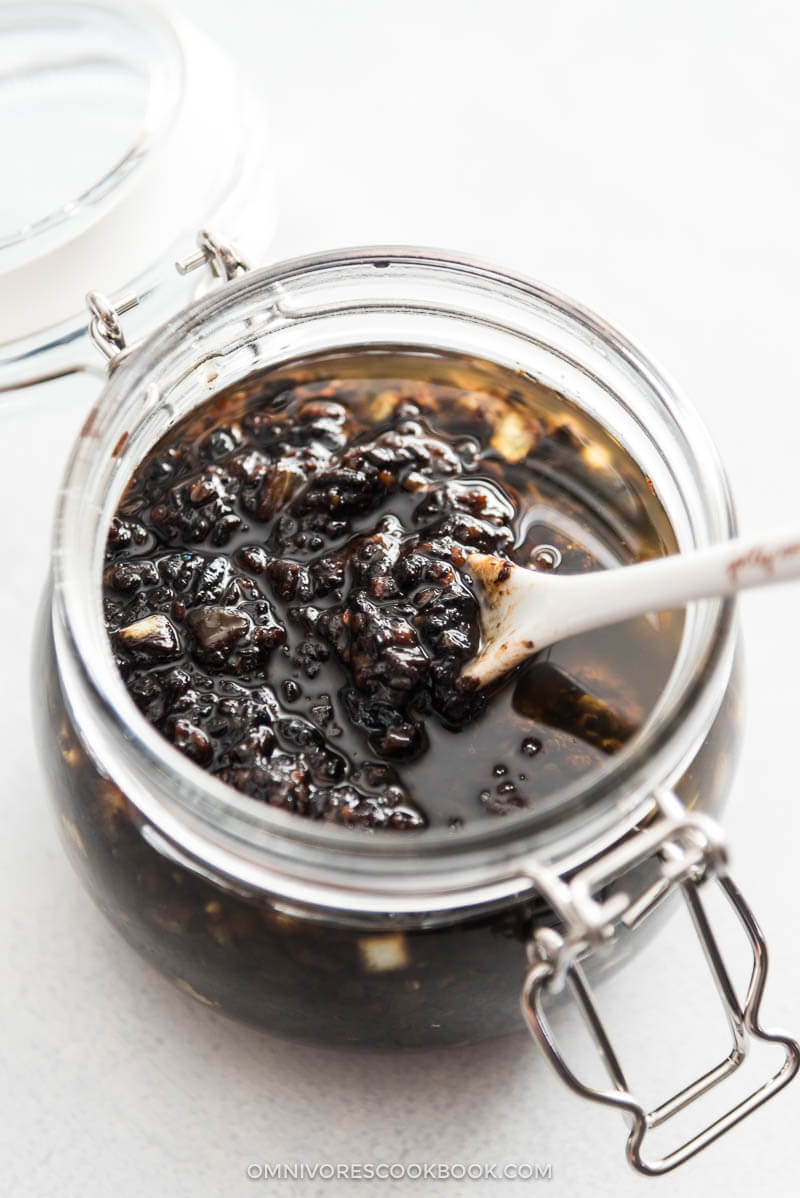
I recommend that everyone who loves Chinese food have a jar of pre-made black bean sauce in their fridge. Here are the reasons:
- The sauce is extremely versatile. You can view it as soy sauce alternative, only more flavorful.
- The sauce is healthier than many other Chinese sauces because it contains less sugar.
- The sauce has a bit of thickening powder by itself, so you don’t always need to use extra cornstarch to thicken the sauce. One more prep step eliminated!
- Not only can you make stir-fried dishes with it, you can also use it to bake or steam food, marinate meat, or serve it as dipping sauce or noodle salad dressing.
Sound amazing?
Introducing Homemade Black Bean Sauce
Yes, you can buy bottled black bean sauce from the grocery store, but the homemade version contains more fresh aromatics, does not use additional starch to thicken the sauce, and contains no additives. I always suggest that you make your own for a more delicious and healthier option.
Basic ingredient – fermented black beans
The most important ingredient is fermented black bean. It has a deep umami flavor that is similar to soy sauce, but different in flavor and even richer. This is the base of the sauce.
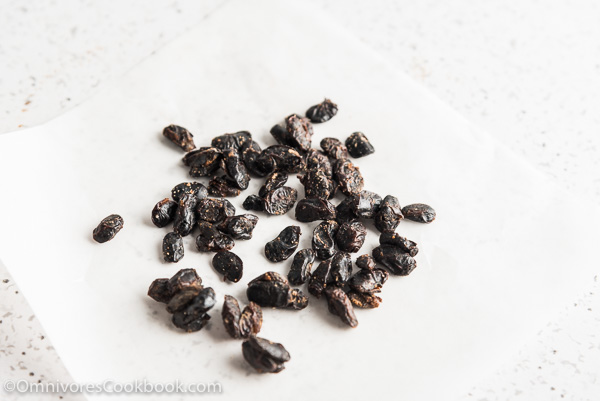
Thanks to almighty Amazon, you can even purchase the fermented black beans online without a trip to grocery store. However, if there is an Asian market nearby, I highly recommend you to get your ingredients there because it will be way cheaper. These black beans can stay in your fridge forever, so you can store them if you don’t have time to use them immediately.
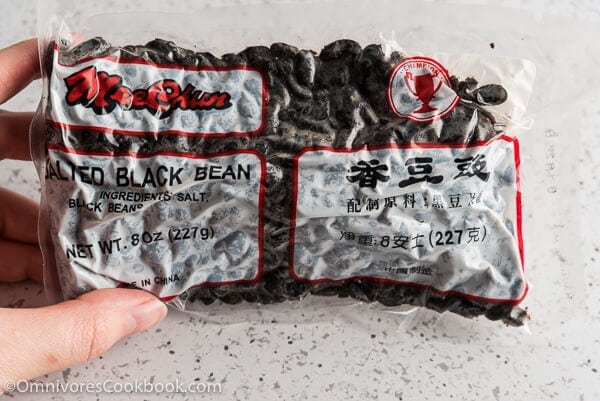
Once you get the fermented black beans, the rest of the ingredients are quite easy to find and it’s more likely that you will already have them at home.
How to prep fermented black beans
(1) To use the fermented black beans, always rinse them with water and drain before using, so they won’t be too salty. Plus, the water will soften them to make the chopping.
(2) I always chop the beans on a cutting board so I can control the texture. I like my bean paste a bit coarse, with bits of black bean chunks to add texture. You can do this step in a food processor as well.
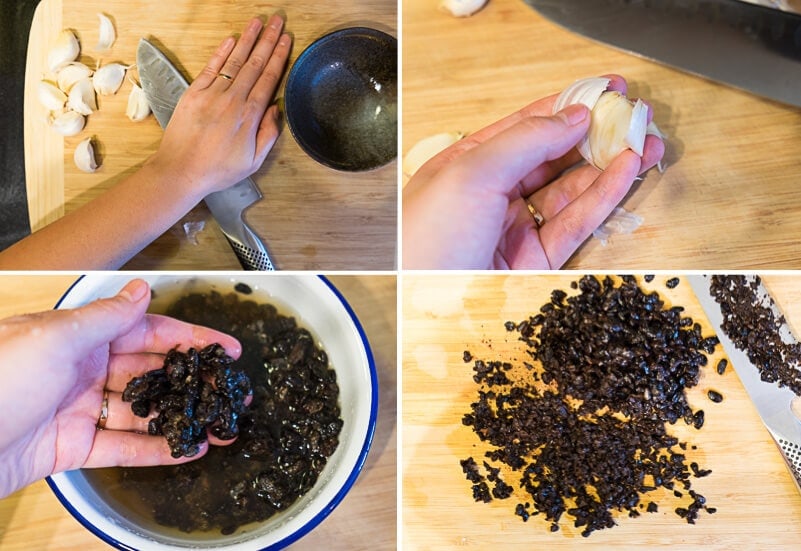
*Tip on peeling garlic faster: Lightly crush it with your chef’s knife by holding it with one hand, and press the flat side with the palm of your other hand. After this simple procedure, you only need 2 seconds to peel a clove.
Once you get all the ingredients ready, slowly roast them in a skillet. It will take 20 to 30 minutes. Please be patient and use low heat, so you won’t burn anything.
The sauce will be ready to use once it’s cooked, but it gets better after storing it for a few days.
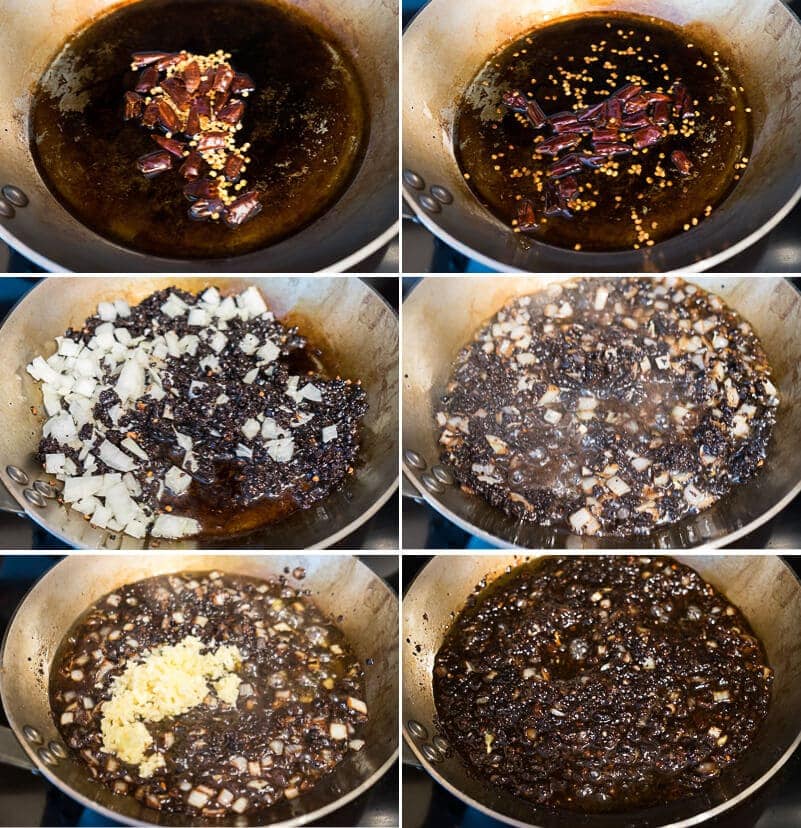
How to use homemade black bean sauce
You can use the sauce for cooking, as a marinade, a dipping sauce, or you can use it to make noodle salad. The sauce uses oil to cover the rest of the ingredients, so it will be preserved for longer time in the fridge. To use the sauce, simply scoop out the portion you need with a bit of oil. The sauce has some thickening power from the bean starch, so it’s not always necessary to add cornstarch slurry like other stir fry sauces.
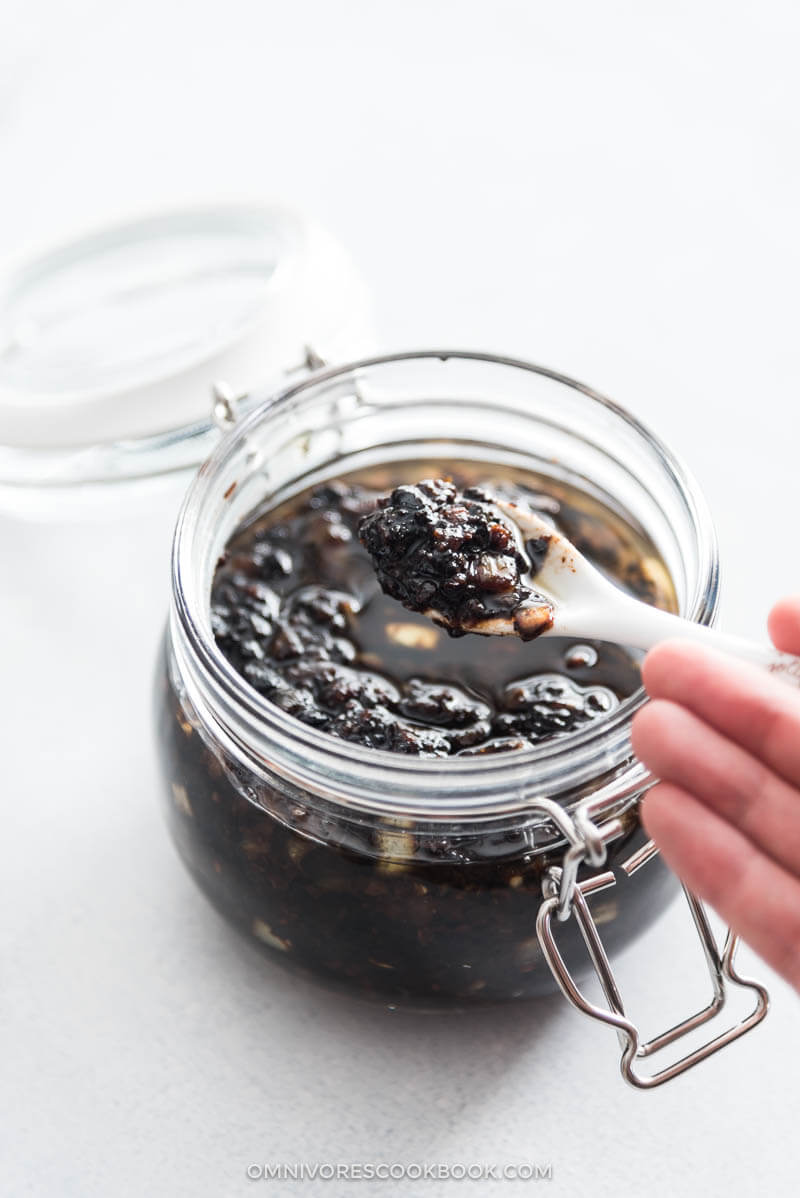
Assuming that you are going to cook 2 servings – you will need about 450 grams (1 pound) protein, or 6 to 8 cups vegetables, or 220 grams (1/2 pound) protein and 3 cups vegetables. You will need 3 to 4 tablespoons sauce.
(1) Pick 1 to 2 aromatics. Prep according to the list below. (Optional)
Since the black bean sauce contains aromatics already, you can skip this step when you’re in a hurry. However, if you have time, some extra aromatic ingredients will always make the dish taste better.
Recommended aromatics
- Ginger – 1 large piece minced (yields 2 teaspoons to 1 tablespoon)
- Green onion – 2 to 3 green onions, coarsely chopped
- Dried chili pepper – 2 to 4 peppers, torn into 3 to 4 pieces. (Or, keep whole for less spiciness.)
- Sichuan peppercorns – 1 to 2 teaspoons. Use it to infuse the hot oil, then discard them before adding other ingredients. (See this recipe to learn how to use them.)
- Shallot or onion – 1 shallot or 1/2 onion, thinly sliced or diced
(2) Choose and cut the protein.
Recommended Protein
- Beef (flank steak or short ribs) – Thinly sliced (1/8 to 1/4-inch thick), or cut to strips for stir fry.
- Chicken (skinless boneless breast or thigh) – Diced to 1-inch pieces, or sliced to 1/4-inch thick pieces for stir fry. Use whole pieces for grilling or baking.
- Pork (tenderloin or loin) – Thinly sliced (1/8 to 1/4-inch thick), or cut to strips for stir fry. Use larger cuts, such as pork chops, for baking, pan searing, or grilling.
- Shrimps – Peeled and deveined for stir fry or grilling.
- Fish fillet – Grilled, baked, or steamed with the sauce.
- Tofu (firm or extra firm) – Diced to 1/2 to 2/3 inch pieces for stir fry or braising.
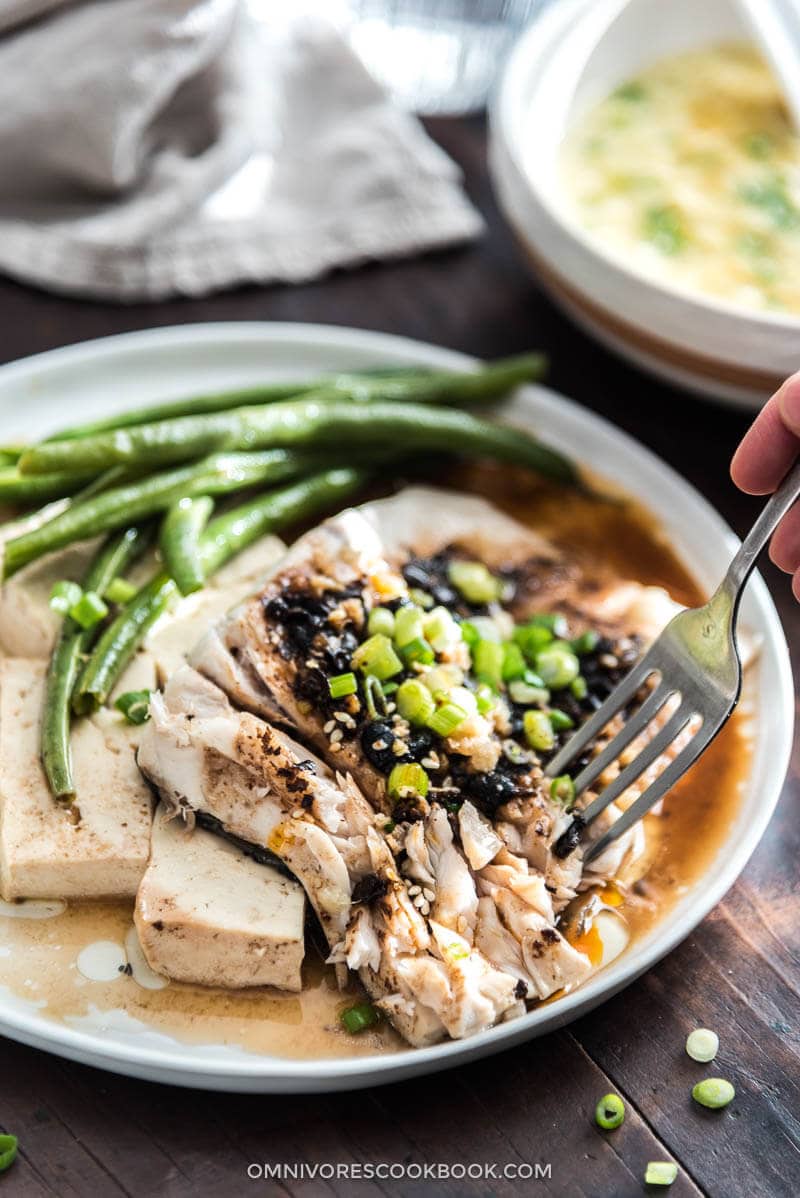
(3) Marinate and prep the protein.
For each pound of meat or seafood (for stir fry), mix with 1 tablespoon vegetable oil (or peanut oil), 1/2 teaspoon salt, and 1 tablespoon cornstarch. Let it marinate for 5 to 10 minutes. Skip this step if you’re using the sauce to bake, grill, or pan fry.
For tofu (for stir fry), marinate with 2 tablespoons soy sauce and 1 tablespoon syrup (or honey) for 10 to 15 minutes. Drain and coat with a thin layer of cornstarch. See this post to learn how to cook crispy tofu without deep-frying. Skip this step if you use the sauce (and stock) to braise tofu.
(4) Cut and prep the vegetables.
To make a quick dinner, my favorite method is to only use one type of vegetable. You can use two, but no more.
Recommended vegetables
- Asparagus – Chopped to 1-inch pieces
- Baby bok choy – Tear off large leaves and halve lengthwise, halve or quarter the rest.
- Bamboo shoots – Sliced
- Bell peppers – Sliced or chopped
- Broccoli (fresh) – Divide to small florets; steam or blanch. (See this post to learn how to blanch the broccoli quickly in the same stir fry pan).
- Broccoli (frozen) – Microwave for 2 to 4 minutes (depending on the quantity), so the broccoli is thawed and luke warm, but not heated up.
- Brussels sprouts – Halved and roasted (See this post for how to roast Brussels sprouts).
- Cabbage (green and red) – Coarsely chopped
- Cauliflower (fresh) – Divide to small florets; steam, blanch, or roast.
- Cauliflower (frozen) – Microwave for 2 to 4 minutes (for stir fry), or roast (see this post to learn how to crisp up frozen cauliflowers in the oven).
- Carrot – Sliced into pieces or strips (by using a julienne peeler); or cut to chunk and roast.
- Celery – Sliced or diced
- Eggplant – Sliced. (See this post to learn how to prep eggplant so it crisps up during stir frying.)
- Green peas (fresh or frozen)
- Kale – Stalk chopped to small pieces, leaves coarsely chopped
- Mustard greens – Chopped
- Mushrooms – Sliced or quartered
- Okra – Sliced
- Onion – Sliced
- Spinach – Roughly chopped for larger spinach. No need to chop baby spinach.
- Snow pea
- Zucchini – Seeded and sliced
(5) Make the stir fry, or use the stir fry sauce for baking, grilling, or steaming
Read this post to learn the basic steps of making Chinese stir fry.
To learn how to use Black Bean Sauce now, go to:
- Chicken Stir Fry with Black Bean Sauce
- Fish with Black Bean Sauce (Steamed and Baked Versions)
- Grilled Chicken with Black Bean Sauce
- Zucchini Stir Fry with Black Bean Sauce
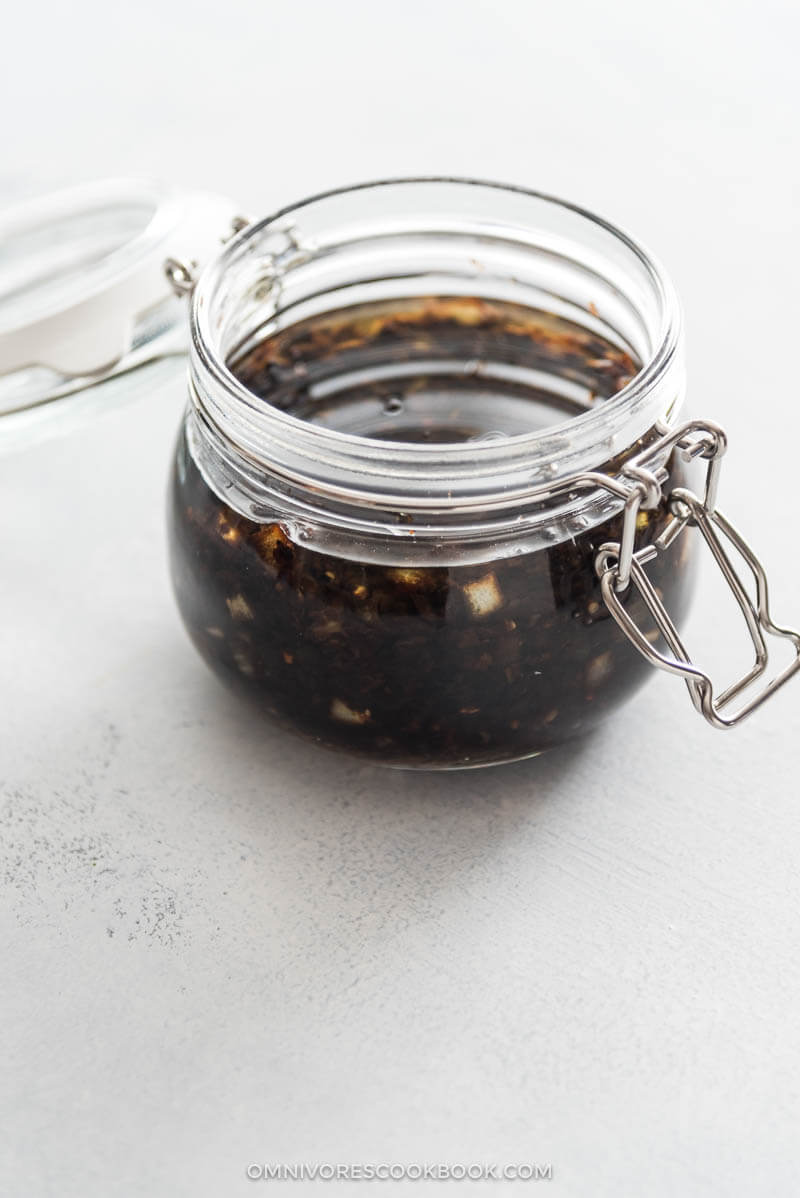
More Chinese sauce recipes
- Hoisin Sauce
- Orange Sauce
- General Tso Sauce
- Kung Pao Sauce
- Vegetarian Oyster Sauce (Vegan Stir Fry Sauce)
If you give this recipe a try, let us know! Leave a comment, rate it (once you’ve tried it), and take a picture and tag it @omnivorescookbook on Instagram! I’d love to see what you come up with.
Chinese Cooking Made Easy
Are you new to this website? This free email series is a great place to start. I’ll walk you through a few of my most popular recipes and show you how and why they work. You’ll quickly start to cook better Chinese food in your own kitchen.
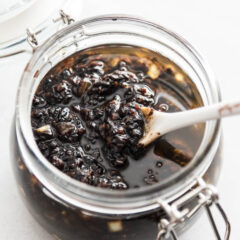
Homemade Black Bean Sauce
Ingredients
- 1 cup fermented black beans
- 1/3 cup vegetable oil
- 1/4 white onion , minced
- 4 to 6 dried chili peppers , torn to small pieces (*Footnote 1)
- 1/4 cup Shaoxing wine (or dry sherry, or Japanese sake) (*Footnote 2)
- 1/4 cup light soy sauce (or soy sauce, or tamari for gluten-free option)
- 1/4 cup sugar (or brown sugar)
- 1 head garlic (8 to 10 big cloves, minced (*Footnote 3)
- 1 thumb ginger , minced (*Footnote 4)
Instructions
- Rinse fermented black beans with tap water, drain, and coarsely chop them. I like to leave some bigger pieces of the beans, to give the sauce more texture.
- (Optional) You can use a food processor to mince all the ingredients. Add black beans, onion, and garlic into a food processor. Blend until both ingredients are minced, but not a fine paste.
- Heat oil and dried chili peppers in a saucepan over medium heat until warm. Turn to medium low heat. Cook until the chili peppers turn dark, but not black. Stir occasionally. Scoop out the chili peppers and discard them.
- Add the black beans and onion. Cook and stir, until the sauce looks a bit dry. (The beans will absorb oil at first, but release the oil once they’re cooked.)
- Add Shaoxing wine, light soy sauce, and sugar. Simmer and stir until the onion turns tender. It takes about 10 minutes or so. The sauce can be easily burned, so make sure to keep the heat low and stir the sauce constantly to ensure even cooking.
- Add garlic and ginger (if you’re using these ingredients). Continue to cook and stir the sauce until the onion turns very tender. You should see oil floating on top of the sauce.
- Transfer the sauce to a large bowl to cool off completely.
- Store the sauce in an airtight jar in the fridge for 2 weeks to a month.
Notes

Did you make this recipe?
I’d love to hear how it turned out for you! Please take a moment to leave a 5-star rating ⭐️ and share your thoughts in the comments further down the page. It really helps others discover the recipe too.

Francine Hamilton
Absolutely delicious! I made this to put on your steamed salmon recipe. All was perfect. Thank you!
Jen
Does this freeze well?
Maggie Zhu
Yes it freezes very well!
Ricj
This sauce is amazing! I just made a tofu & veggie stir-fry with it that was awesome; also delicious with fish.
Thanks again, Maggie
Vonnie
Hi. Is it possible to replace the sugar to be healthier?
Maggie Zhu
The sugar adds a nice fragrance to the sauce and it mellows the salty taste of the sauce. That’s being said, you can skip the sugar or reduce it. The sauce will be more pungent but should still be tasty.
Lena
This is delicious! I love the flavor of fermented black beans, but takeout places usually oversaturate their proteins, and jar sauces are so salty. With your recipe I can control the amount and use the sauce for other dishes. I truly love the recipe. Posted photos (multiple, including just the resulting sauce) on Instagram, tagged and hashtagged. Thanks again!
M
WOW this recipe is so delicious. I followed the recipe exactly but cooked it a bit longer on low heat. I made a simple fried rice with slices of pork chashu and scrambled eggs. What I did with this sauce is pure magic… to a small sauce pan I added 1 cup of water and brought it to a simmer and added chicken stock powder than 3 tbsp of the black bean sauce, stirred it up then added cornstarch slurry to thicken it. Poured on top of rice. Amazingly delicious. It’s incredible thanks so much for this amazing recipe.
Quinn
Absolutely fantastic! Used it to top oil-poached flounder fillets along with sliced scallions. Huge hit!
Sunny
So so delicious! Since learning how to make my own five spice powder and seeing how massive the difference is between that and store-bought, I thought it’d be worth it to give making this black bean sauce a go. Equally as big a difference. Thanks so much for sharing this recipe!
Penny
Super delicious. Made for the mapo tofu recipe but my favorite use is just to add to suateed veggies and/or scrambled eggs
Dan
Inches ?
The rest of the world uses metric, they dumped imperial measures some 50 years ago (half a century !). Not only is America the only nation on the planet to refuse to drop the obsolete measures but, American Imperial Measures are also smaller than Imperial measures from other nations. A cup is not always a cup.
e.g.
1 US Gallon = 3.75 liter
1 UK Gallon = 4.54 liter
Gallons also change between other nations, hence the global conversion to scientific metric standard, metric is the same no matter what nation you are in, a liter is a liter, a millimeter is a milliliter. What is 1/8th of an inch ? (It is hard to find rulers or measure tapes with imperial in the rest of the world)
Renita
It tastes great! i have a question. After i made this, the amount of oil doesn’t look the same as in your picture. Should i top up with some shallots oil in the jar?
Maggie Zhu
Depending on the fermented black bean you use and your stove strength, the beans might have absorbed more oil. It’s not a problem for the taste of the sauce. But if you plan to preserve it for a longer time, a thin layer of oil on top of the sauce will help a lot!
Kathy
Wow. The SCRUMPTIOUS sauce is still on the stove for last cooking. I fermented the beans myself (very easy4- day process. Not being satisfied with my rough chop of the beans, I used a potato masher to break them up further as they cooked. Further I used the chili oil recipe from this site for the oil! so it is a bit hot…but also with a sweet tang. Thank you so much! The only thing I found a bit difficult was guessing as to the amount of time for each step…that information would be most helpful, as I am a complete newbie to this sauce….
J
Hi Maggie, love your site and your recipes. Due to a recent medical condition, I need to go low-sodium. Do you think I can substitute the soy and sugar combination for for coconut aminos instead?
Maggie Zhu
I’ve heard many people using coconut aminos to replace soy sauce and water, but I personally don’t like it.
The aminos tastes so sweet and does not have the depth of flavor that regular soy sauce does.
If you can find it, I like Yamasa’s less salt (reduced sodium) soy sauce. Its sodium content is about half of regular soy sauce (but still double the sodium content of coconut aminos). If it’s still too much sodium, I guess coconut aminos might be the only option.
2HotnAZ
Hi, Maggie! I made this sauce last weekend and it turned out pretty well. I used Arbol chilies. My only complaint is that it was a little too sweet for my palate; I prefer savory unami.
Also, can you suggest any Asian spices/sauces that don’t use MSG?
Mark
Great recipe, I will definitely make again. I served with a turkey breast stirfry and added some sesame seeds, but thinking some cashews would work really well with this. Next time.
Gregory Crawford
Fabulous! I made the sauce and then added it to a general vegetarian stir-fry and it was terrific. Thank you!
Ken Savage
Dear Maggie,
I’m learning to cook Chinese dishes at home and am enjoying your recipes. I’d like to make the black bean sauce but worry that the amount it makes won’t be used before the 2 weeks – month safe storage time elapses. I suppose I can cut the recipe in half but I wonder if the sauce can be frozen? Also, would Sichuan chile pepper work to give the sauce a little heat? Thank you for this terrific web site.
Ken
Maggie
The sauce can actually stay well in the fridge for pretty long time, but I usually give a period of time that’s rather conservative. Sometimes I store mine for 1 to 2 weeks without any problems. That being said, you can definitely freeze this sauce. It’s freezer friendly.
Yes, you can definitely add some chili pepper to add heat. It will taste delicious.
Ken Savage
Thank you so much. I’m amazed that you responded so quickly and appreciate it very much. I’ll give it a try.
Ken
Avishi
How to ferment the black beans? Or do we have to buy it.
Maggie
You can but them at Asian market or online stores:http://amzn.to/1PM90DG https://themalamarket.com/collections/all/products/fermented-black-beans-douchi?aff=2
Starr
I love the flavor of this sauce, but mine came out quite dry. Should I add more oil (in the storage jar) to make it look like your photo?
Thanks!
Maggie
Yeah, adding more oil definitely helps! Depending on the cooking time, the black beans might have absorbed more oil. You can add more after cooking as well. A thin layer on top will help preserve the sauce for a longer time.